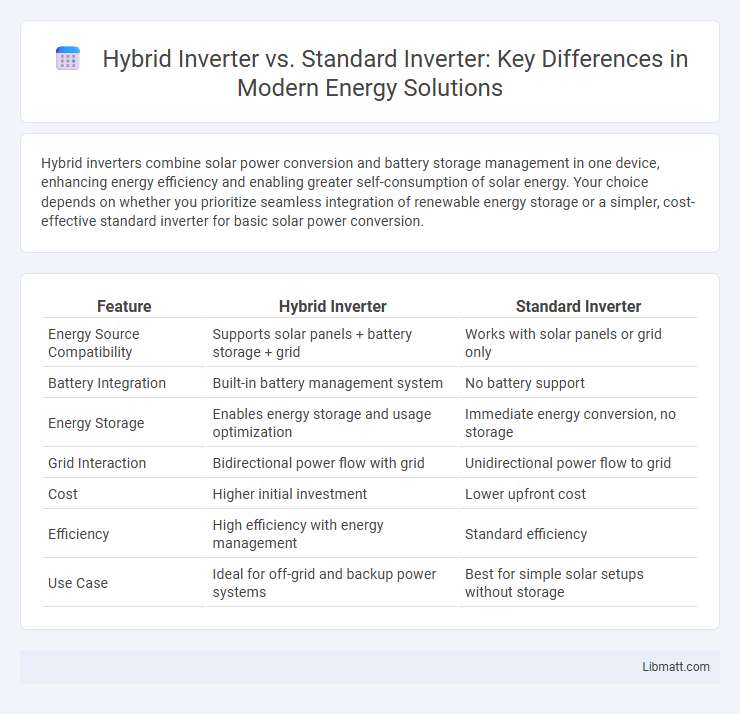Hybrid inverters combine solar power conversion and battery storage management in one device, enhancing energy efficiency and enabling greater self-consumption of solar energy. Your choice depends on whether you prioritize seamless integration of renewable energy storage or a simpler, cost-effective standard inverter for basic solar power conversion.
Table of Comparison
| Feature | Hybrid Inverter | Standard Inverter |
|---|---|---|
| Energy Source Compatibility | Supports solar panels + battery storage + grid | Works with solar panels or grid only |
| Battery Integration | Built-in battery management system | No battery support |
| Energy Storage | Enables energy storage and usage optimization | Immediate energy conversion, no storage |
| Grid Interaction | Bidirectional power flow with grid | Unidirectional power flow to grid |
| Cost | Higher initial investment | Lower upfront cost |
| Efficiency | High efficiency with energy management | Standard efficiency |
| Use Case | Ideal for off-grid and backup power systems | Best for simple solar setups without storage |
Overview of Hybrid and Standard Inverters
Hybrid inverters combine solar energy conversion with battery storage management, enabling efficient use of renewable energy alongside grid power for increased energy independence. Standard inverters solely convert DC solar power into AC electricity without integrating energy storage solutions. Understanding the benefits of a hybrid inverter can help you optimize energy usage and improve system resilience.
Key Differences Between Hybrid and Standard Inverters
Hybrid inverters combine solar energy with battery storage, enabling energy management during both day and night, unlike standard inverters that solely convert DC from solar panels to AC for immediate use. Standard inverters depend entirely on grid power when solar output is insufficient, whereas hybrid inverters provide backup power by switching to stored battery energy, enhancing your energy independence. The integration of advanced energy management features in hybrid inverters optimizes electricity usage, reduces reliance on the grid, and supports load shifting, setting them apart from the basic functionality of standard inverters.
How Hybrid Inverters Work
Hybrid inverters combine the functions of a solar inverter and battery charger, efficiently managing power from solar panels, batteries, and the grid. They convert DC electricity from solar panels or batteries into AC power for your home while intelligently switching between energy sources to optimize usage and storage. Your energy system benefits from seamless integration, enhanced backup capabilities, and improved energy independence.
How Standard Inverters Operate
Standard inverters convert direct current (DC) from solar panels or batteries into alternating current (AC) for household or commercial use, functioning purely as power converters without energy storage management. They rely on the grid or external battery systems to supply energy when solar generation is insufficient, lacking integrated battery charging or discharging controls. Your energy system's efficiency depends on the standard inverter's capacity to handle power fluctuations without offering hybrid capabilities like load management or backup power during outages.
Energy Efficiency: Hybrid vs Standard Inverters
Hybrid inverters exhibit higher energy efficiency compared to standard inverters by integrating solar power management with battery storage, reducing energy loss during conversion and storage processes. Standard inverters primarily convert DC to AC without optimizing energy flow from renewable sources or storage, leading to potential inefficiencies. The superior efficiency of hybrid inverters contributes to lower electricity costs and enhanced sustainability in solar energy systems.
System Compatibility and Scalability
Hybrid inverters offer greater system compatibility by integrating seamlessly with solar panels, batteries, and the grid, enabling efficient energy management and storage solutions. Standard inverters primarily convert DC to AC for immediate use, lacking scalability to incorporate future energy storage or expanded solar capacity. Choosing a hybrid inverter future-proofs your system, allowing easy upgrades and expansion as your energy needs grow.
Cost Comparison: Hybrid vs Standard Inverters
Hybrid inverters generally have a higher upfront cost compared to standard inverters due to their advanced technology that integrates solar energy storage with grid power management. However, hybrid inverters can reduce long-term expenses by optimizing energy usage and providing backup power during outages, potentially lowering your electricity bills. Standard inverters offer a more affordable initial investment but lack the versatility and energy-saving benefits of hybrid systems, often leading to higher operational costs over time.
Installation and Maintenance Requirements
Hybrid inverters require more complex installation due to their dual functionality of managing both solar panels and battery storage systems, often necessitating professional setup and configuration for optimal performance. Standard inverters have simpler installation processes since they only convert DC to AC power from solar panels, generally allowing for quicker setup and lower initial costs. Maintenance for hybrid inverters involves monitoring both energy conversion and battery health, which can be more demanding compared to standard inverters that primarily focus on power conversion efficiency.
Pros and Cons of Hybrid Inverters
Hybrid inverters combine solar power management with energy storage capabilities, enabling you to store excess energy in batteries for use during outages or peak demand, improving energy self-sufficiency and grid independence. They offer increased efficiency and flexibility compared to standard inverters, which only convert solar energy without storage support, but hybrid inverters typically have a higher upfront cost and more complex installation requirements. Choosing a hybrid inverter can maximize your energy savings and resilience, especially in areas with frequent power interruptions or time-of-use electricity rates.
Pros and Cons of Standard Inverters
Standard inverters convert DC power from solar panels or batteries into usable AC electricity with high efficiency and reliable performance, making them suitable for simple solar power setups. They are typically more affordable and easier to install than hybrid inverters but lack the advanced battery management and backup power capabilities that hybrid systems offer. Your choice depends on whether you prioritize cost-effectiveness and straightforward operation over energy storage flexibility and grid independence.
Hybrid inverter vs Standard inverter Infographic

 libmatt.com
libmatt.com